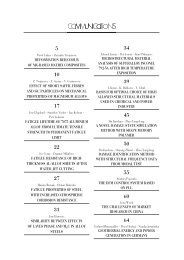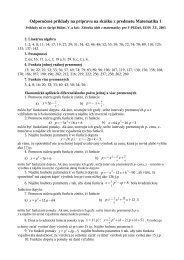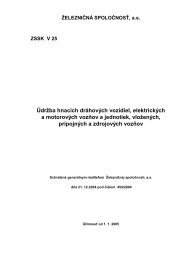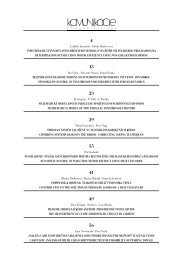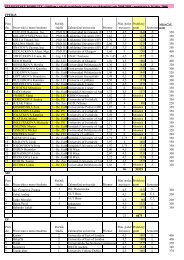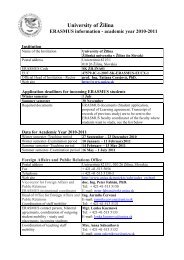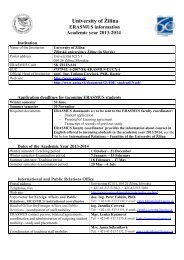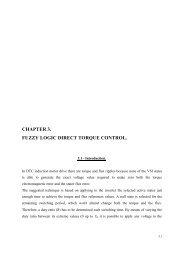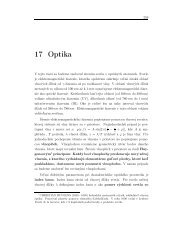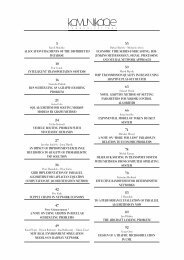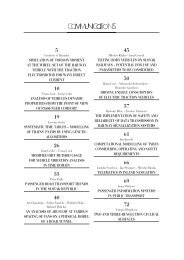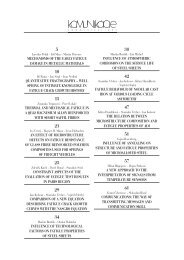posudzovanie vplyvu automobilovej dopravy na ... - Žilinská univerzita
posudzovanie vplyvu automobilovej dopravy na ... - Žilinská univerzita
posudzovanie vplyvu automobilovej dopravy na ... - Žilinská univerzita
You also want an ePaper? Increase the reach of your titles
YUMPU automatically turns print PDFs into web optimized ePapers that Google loves.
C O M M U N I C A T I O N S<br />
I S<br />
pod temenom koľajnicového<br />
pása. Rovi<strong>na</strong> priečneho rezu je<br />
zvislá rovi<strong>na</strong>, v pôdoryse kolmá<br />
<strong>na</strong> os koľaje. Temená koľajnicových<br />
pásov sú body dotyku<br />
spoločnej dotyčnice k horným<br />
plochám oboch hláv koľajnicových<br />
pásov ležiacich v rovine<br />
priečneho rezu. Geometrické<br />
Gauge<br />
Obr. 1 Profil hlavy koľajnice<br />
Fig. 1 Rail head profile<br />
usporiadanie koľaje tvorí rozchod koľaje, smerová a výšková poloha<br />
koľajnicových pásov a ich sklon v rovine priečneho rezu. Rozchod<br />
koľaje je vzdialenosť pojazdných hrán koľajnicových pásov meraná<br />
v rovine priečneho rezu. Pozdĺž<strong>na</strong> výška koľajnicových pásov je<br />
výškový priebeh temien koľajnicových pásov. Smer koľajnicového<br />
pása je priebeh pojazdnej hrany koľajnicového pása v pôdoryse.<br />
of the rail head, 14 mm under the<br />
crown of the rail head. The diago<strong>na</strong>l<br />
section area is a vertical area in the<br />
ground plan orthogo<strong>na</strong>l to the rail<br />
axis.<br />
Rail head crowns are contact<br />
points of the common tangent line,<br />
with the upper surfaces of the rail,<br />
lying in the diago<strong>na</strong>l section area. Geometrical<br />
position of the track is created with the gauge of the railways,<br />
directive and altitudi<strong>na</strong>l position and their decli<strong>na</strong>tion in the<br />
diago<strong>na</strong>l section area. The gauge of the railway is the distance of<br />
the movable edges of the rails, measured in the diago<strong>na</strong>l section<br />
area. The longitudi<strong>na</strong>l height of the rail is the height course of the<br />
rail crowns. Direction of the rail is the course of the movable edge<br />
of the rail in the ground area.<br />
3. Profil hlavy železničnej koľajnice<br />
Podľa tvaru plochy obrazca v priečnom reze je možné koľajnice<br />
zaradiť do dvoch skupín. Jednu tvoria koľajnice so širokou<br />
pätou, používané v prevažnej miere pre železničné trate, druhú<br />
koľajnice žliabkové, používané prevažne pri stavbe tratí pre vozidlá<br />
mestskej hromadnej <strong>dopravy</strong>. Najexponovanejšími časťami koľajnice<br />
sú hlava a päta. Hlava je zaťažovaná zvislými, priečnymi a pozdĺžnymi<br />
silami, ktoré vyvodzujú kolesá vozidla, <strong>na</strong> pätu pôsobia<br />
reakčné sily podpôr. Zatiaľ, čo sa päta počas svojej životnosti<br />
takmer vôbec neopotrebuje, hlava koľajnice je zaťažená a opotrebovaná<br />
vo zvislom aj priečnom smere. Koľajnica je opotrebená<br />
v priečnom smere hlavne v oblúkoch <strong>na</strong> vonkajších koľajnicových<br />
pásoch.<br />
V ďalších úvahách sa budeme zaoberať geometriou a zmenou<br />
geometrie hlavy koľajnice so širokou pätou, typu UIC 60.<br />
Zme<strong>na</strong> ideálnej polohy koľajnicových pásov počas prevádzky<br />
vozidiel, nie je <strong>na</strong> celej dĺžke rov<strong>na</strong>ká.<br />
V niektorých miestach sa môže modifikácia prejaviť ako úbytok<br />
materiálu opotrebenie, v niektorých prípadoch ako lokálny prírastok.<br />
Opotrebenie koľaje sa v niektorých prípadoch vyhodnocuje<br />
on-line <strong>na</strong> reálnej trati pri experimentálnom určovaní geometrickej<br />
polohy koľaje. V iných prípadoch sa môže vyko<strong>na</strong>ť a<strong>na</strong>lýza off-line<br />
<strong>na</strong> základe <strong>na</strong>meraných a zaz<strong>na</strong>me<strong>na</strong>ných súborov priečnych profilov<br />
koľajníc. V obidvoch prípadoch sa <strong>na</strong>merané hodnoty profilov<br />
v určenom intervale priečnej súradnice porovnávajú s referenčným<br />
teoretickým profilom koľajnice. Dôležitým parametrom pre určovanie<br />
opotrebenia materiálu koľaje je sklon koľajnicových pásov.<br />
Trate európskych železníc sú stavané hlavne so sklonom 1:40. Na<br />
tratiach Slovenských železníc sa používa sklon 1:20.<br />
3. Rail head profile<br />
In accordance with the shape area in the diago<strong>na</strong>l section it<br />
is possible to classify the rails to two groups. The first group is<br />
created by the rails with wide foot which is used in overwhelming<br />
rate for railway track, the second is created with the grooved rails<br />
used in overwhelming rate for town mass transport. The head and<br />
the foot are maximum force loaded parts of the rail. The head is<br />
loaded with vertical, diago<strong>na</strong>l and longitudi<strong>na</strong>l forces, acting from<br />
vehicle wheels to rail heads. The reaction forces of the supports<br />
act on the rail foot. Meanwhile the rail foot is not during its life<br />
cycle practically worn, the rail head is forced and worn in the vertical<br />
and diago<strong>na</strong>l direction. The rail is worn in the diago<strong>na</strong>l direction<br />
mainly in the curves on outer rails.<br />
Further we will deal with the geometry and change of the foot<br />
rail UIC60 geometry.<br />
Change of the ideal position of the rails during vehicles operations<br />
is not iquel on the whole length. Change can be observed<br />
in some places as a material shrinkage wearing, in some cases<br />
as a local material accumulation. Rail wearing is in some cases<br />
assessed on-line on the real track with the experimental assessment<br />
of the geometrical position of the track. In other cases the<br />
off-line a<strong>na</strong>lysis on the ground of measured and saved lateral rail<br />
profile files can be carried out. The measured values of the profiles<br />
will be in all cases determined with the lateral coordi<strong>na</strong>te<br />
interval compared with the reference rail profile. The canting of<br />
rail is an important parameter for rail material wearing assessment.<br />
The tracks of the European railways are built mainly with<br />
the canting of rail of 1:40. The canting of rail of 1:20 is used on<br />
the Slovak railways.<br />
4. Kontaktné body geometrického profilu železničného<br />
kolesa a koľajnice<br />
Oblasťou intenzívneho pôsobenia síl spôsobujúcich opotrebenie<br />
koľajníc je oblasť kontaktu kolesa a koľajnice.<br />
Prvým krokom vedúcim k identifikácii rozsahu kontaktnej<br />
oblasti je a<strong>na</strong>lytické určenie kontaktných bodov.<br />
4. Wheel and rail profile geometry contact points<br />
The forces inducing the rail wearing act intensively in the<br />
wheel – rail contact area.<br />
The first step leading to contact area range identification is<br />
the a<strong>na</strong>lytical contact point assessment.<br />
44 ● KOMUNIKÁCIE / COMMUNICATIONS 1/2003



